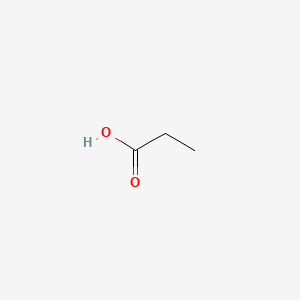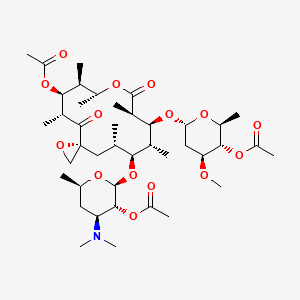Possible associated with:
| Structure | name | description | Reference count |
|---|---|---|---|

|
propionic acid | propionic acid is a lipid of Fatty Acyls (FA) class. Propionic acid is associated with abnormalities such as Epilepsy, Infection, Tuberculosis, Alkalosis and Ischemia. The involved functions are known as Uptake, Biosynthetic Pathways, Methylation, Protein Overexpression and Biochemical Pathway. Propionic acid often locates in Body tissue, Cytoplasmic matrix, Membrane, Protoplasm and Extracellular. The associated genes with propionic acid are TRIO gene, TRRAP gene, SLC5A8 gene, SLC33A1 gene and Homologous Gene. The related lipids are Fatty Acids, Propionate, butyrate, Valerates and mycocerosic acid. | 7360 |

|
erythromycin | erythromycin is a lipid of Polyketides (PK) class. Erythromycin is associated with abnormalities such as Systemic Inflammatory Response Syndrome, Pneumonia, Infection, Pneumococcal Infections and Exanthema. The involved functions are known as Pharmacodynamics, Sterility, Agent, Drug Kinetics and Adjudication. Erythromycin often locates in Blood, peritoneal, Extracellular, Ribosomes and apicoplast. The associated genes with erythromycin are P4HTM gene, SLC33A1 gene, FAM3B gene, Operon and Homologous Gene. The related lipids are Hydroxytestosterones, Steroids, Propionate, Mycolic Acids and campesterol. The related experimental models are Mouse Model and Knock-out. | 19871 |

|
clarithromycin | clarithromycin is a lipid of Polyketides (PK) class. Clarithromycin is associated with abnormalities such as Helicobacter Pylori Infection, Infection, Coinfection, Gastritis and Peptic Ulcer. The involved functions are known as Point Mutation, Increased Sensitivy, Bacterial resistance, urease activity and Mutation. Clarithromycin often locates in Blood, Gastric mucosa, Biopsy sample, Respiratory System and Entire gastrointestinal tract. The associated genes with clarithromycin are Genes, rRNA, rRNA Operon, Genome, HM13 gene and GDF15 gene. The related lipids are 9,11-linoleic acid, Steroids, Lysophosphatidylcholines, Lipopolysaccharides and 4-hydroxycholesterol. The related experimental models are Mouse Model, Knock-out and Experimental Pneumococcal Meningitis. | 10449 |

|
TROLEANDOMYCIN | TROLEANDOMYCIN is a lipid of Polyketides (PK) class. Troleandomycin is associated with abnormalities such as Xanthomatosis, Cerebrotendinous and Jaundice, Obstructive. The involved functions are known as Binding (Molecular Function), Anabolism, hydroxylase activity, Oxidation and immunoreactivity. Troleandomycin often locates in Microsomes, Liver, Human tissue, Microsomes, Hepatic and Immune system. The associated genes with TROLEANDOMYCIN are CYP3A5 gene, CYP3A7 gene, CYP2D6 gene, P4HTM gene and CYP2C19 gene. The related lipids are Androstenes, androstan-17-one, 25-hydroxycholesterol, Sterols and 4-hydroxycholesterol. | 948 |
Total
4